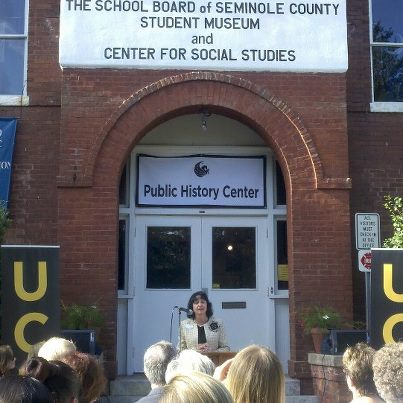The University of Central Florida’s new Public History Center held its first open house Monday to meet with project collaborators and supporters, and share plans for turning a 110-year-old Sanford school building into a learning laboratory for education, research and community engagement.
Representatives from the university, Seminole County Public Schools, Sanford, various history groups and the community were on hand as the tower bell was clanged by Rosalind Beiler, UCF’s director of Public History, and Walt Griffin, Seminole school superintendent, to ring in the new school year.
Sanford “is providing the perfect place for students to learn public history,” said Beiler as she welcomed about 125 people to the school building that still has a picture of President Teddy Roosevelt in the center’s original 1902 classroom. The center soon will offer community workshops, promote involvement in historic preservation and expand programs for K-12 students.
Tina Calderone, chairwoman of the Seminole County School Board, added that the new collaboration will help students “walk the walk of history” by experiencing new exhibits and programs at the center.
The center began as Sanford’s first high school, and later became a grammar school in 1911. In 1984 it was listed on the National Register of Historic Places and became the school district’s Student Museum and Center for the Social Studies, an interpretive center and a hands-on teaching museum.
UCF signed a lease on the building in the heart of Sanford’s residential historic district, and hopes the facility becomes a model for other Central Florida public history centers.
The center has several themed rooms in addition to the classroom. There’s also a pioneer room with a log cabin and tools; Grandma’s Attic with vintage household items and clothes; a Timucua room that represents a 1,200-year-old village; Georgetown and Crooms High School exhibits that feature the city’s African-American community, and other displays.
Behind the museum is a demonstration garden that contains Florida native plants, vegetables and flowers grown at the turn of the last century, antique roses, field crops and other horticultural displays.
